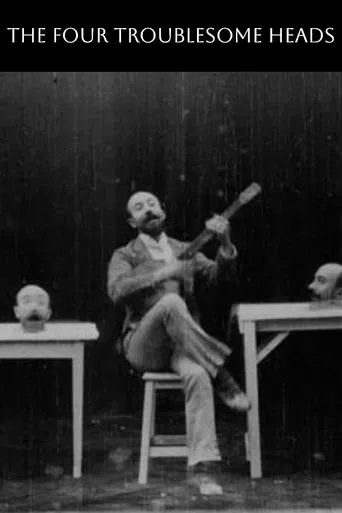Fluentiama
Perfect cast and a good story
InformationRap
This is one of the few movies I've ever seen where the whole audience broke into spontaneous, loud applause a third of the way in.
Rosie Searle
It's the kind of movie you'll want to see a second time with someone who hasn't seen it yet, to remember what it was like to watch it for the first time.
Raymond Sierra
The film may be flawed, but its message is not.
ofpsmith
Like with many of Georges Melies's films, this is an early experiment into special effects. The plot sees a magician making three copies of his head and placing them on the tables. Then they sing a song with Melies himself at the guitar. That's about it. Like with a lot of Melies's films it's short, but groundbreaking in terms of special effects. This film is more than 100 years old, (118 at the time of this writing) and the special effects still look good. Just think how this must of looked back in 1898. That's about all I have to say. Go check it out. If you end up not liking it, then it only ended up taking a minute of your time.
ackstasis
Early French filmmaker Georges Méliès is universally known as a pioneering cinematic visionary, courtesy of the phenomenal success of his most famous film, 'Le Voyage dans la lune / A Trip to the Moon (1902).' However, the director's undeniable genius is also apparent in many of his earlier, lesser-known shorts, most running less than one minute in length. Throughout the 1890's, most filmmakers had only exploited the cinematic medium for experimental or documentary purposes, capturing images of everyday objects or situations. Méliès, a magician by trade, saw things much differently. He imagined cinema being used to translate the impossible onto screen, to surprise and baffle the audience, to transport them into a world unlike their own. His 'Un homme de têtes / The Four Troublesome Heads' of 1898 is an absolute gem, and an incredible exhibition of how far Méliès was ahead of his time in terms of visual effects.The film begins when a magician (as always, played by Méliès himself) appears on stage and, remarkably, removes his own head. When he places the singing head onto the table, a new one suddenly appears on the his shoulders, and the magician and the head interact with each other, with the former scrambling beneath the table to prove to the audience that he is not playing a cheap magical trick on them. The magician repeats this stunning feat twice more, until there are three enthusiastically singing Méliès heads sitting on the table, and the intact magician entertains them with his banjo.Probably the first use of split-screen in cinema history, the visual effects in 'Un homme de têtes' are nothing short of remarkable. The countless uses of split screen, dissolves and double exposures blend seamlessly into the finished product, convincingly passing itself off as having been filmed in a single take. The director's extraordinary on screen charisma is once again on show for all to see, and you can certainly tell that he was formerly a magician; his vibrant enthusiasm for the performance is almost infectious. There's also the sheer casualness with which Méliès removes his own head, as if it's nothing at all to him. Despite already knowing that an exceptional amount of work must have gone into producing the film, somehow it is all made to seem so easy… almost like magic.
Snow Leopard
This early Georges Méliès fantasy feature is outstanding for 1898, both in its convincing special visual effects and in its witty good humor, and it's still lots of fun to watch today. There are quite a few lesser-known gems among Méliès's many fantasy features, and this is one of the best ones.The setup is simple, but Méliès uses it with great skill and imagination. Méliès himself appears on screen, and does tricks with his own head. As elementary as the camera tricks are, Méliès was already expert at using them, and as a result most of the illusions are seamless and very enjoyable. There is also a good deal of humor in the ways that Méliès interacts with all of the "Troublesome Heads". Any film that still survives from the 1890s is usually worth seeing for its historical value, and most of them also provide some kind of interesting information on the techniques or subject matter of the earliest movies. But this is one feature whose value goes well beyond the historical. It's enjoyable in itself, and it is also one of the earliest examples of the genius of one of cinema's most extraordinary pioneers.
KuRt-33
I saw that one teen boy gave this short (how else to call a movie lasting only 50 seconds?) a poor 2 out of 10. No sense of history there. Un Homme de Têtes may not even last a minute, but it's incredibly fast-paced and extremely well done. Hey, it even looks more convincing than most of those computer-generated special effects you see in the cinemas these days.
Méliès takes off his head a few times and sings a song with the head clones. A simple idea but brilliantly executed by the cinemagician (as the French DVD aptly describes this pioneer).

